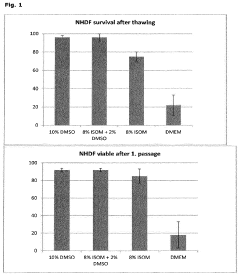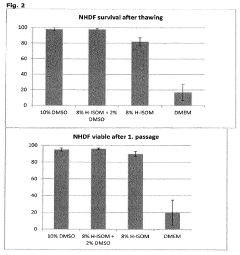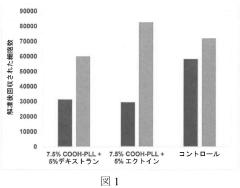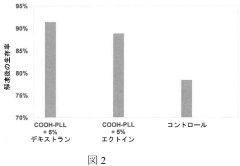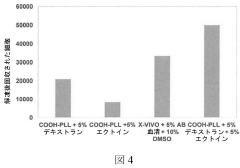Advances in Isopentane-Based Cryoprotectants for Biological Samples
JUL 25, 20259 MIN READ
Generate Your Research Report Instantly with AI Agent
Patsnap Eureka helps you evaluate technical feasibility & market potential.
Cryoprotectant Evolution
The evolution of cryoprotectants has been a critical aspect in the advancement of biological sample preservation. The journey began with the discovery of glycerol's cryoprotective properties in the 1940s, marking the first significant milestone in this field. This breakthrough led to the development of various cryoprotective agents (CPAs) over the subsequent decades, each with its unique characteristics and applications.
In the 1960s and 1970s, dimethyl sulfoxide (DMSO) emerged as a powerful cryoprotectant, offering superior penetration and protection for a wide range of cell types. This period also saw the introduction of other penetrating CPAs such as ethylene glycol and propylene glycol, expanding the toolkit for cryopreservation specialists.
The 1980s and 1990s witnessed a shift towards the development of non-penetrating cryoprotectants, including various sugars and polymers. These agents provided protection by stabilizing cell membranes and reducing mechanical stress during the freezing process. Concurrently, researchers began exploring combinations of different CPAs to harness synergistic effects and minimize individual agent toxicities.
The turn of the millennium brought about a renewed interest in natural cryoprotectants, inspired by organisms capable of surviving extreme cold. Antifreeze proteins and ice-binding proteins from cold-adapted species became subjects of intense study, leading to novel approaches in cryopreservation techniques.
In recent years, the focus has shifted towards developing more efficient and less toxic cryoprotectants. This trend has led to the exploration of isopentane-based cryoprotectants, which have shown promising results in preserving biological samples. Isopentane, with its low freezing point and excellent heat transfer properties, offers rapid and uniform cooling, crucial for maintaining sample integrity.
The evolution of isopentane-based cryoprotectants represents a significant leap forward in the field. These agents combine the benefits of traditional penetrating CPAs with improved safety profiles and reduced cellular toxicity. Their development has been driven by the need for more effective preservation methods in various biomedical applications, including organ transplantation, stem cell research, and regenerative medicine.
As research continues, the trajectory of cryoprotectant evolution points towards increasingly sophisticated and tailored solutions. The future may see the development of "smart" cryoprotectants that can adapt to specific cellular environments or respond to external stimuli during the freezing and thawing processes. Additionally, the integration of nanotechnology and advanced materials science is expected to yield novel cryoprotective strategies, further enhancing our ability to preserve biological samples with unprecedented precision and efficacy.
In the 1960s and 1970s, dimethyl sulfoxide (DMSO) emerged as a powerful cryoprotectant, offering superior penetration and protection for a wide range of cell types. This period also saw the introduction of other penetrating CPAs such as ethylene glycol and propylene glycol, expanding the toolkit for cryopreservation specialists.
The 1980s and 1990s witnessed a shift towards the development of non-penetrating cryoprotectants, including various sugars and polymers. These agents provided protection by stabilizing cell membranes and reducing mechanical stress during the freezing process. Concurrently, researchers began exploring combinations of different CPAs to harness synergistic effects and minimize individual agent toxicities.
The turn of the millennium brought about a renewed interest in natural cryoprotectants, inspired by organisms capable of surviving extreme cold. Antifreeze proteins and ice-binding proteins from cold-adapted species became subjects of intense study, leading to novel approaches in cryopreservation techniques.
In recent years, the focus has shifted towards developing more efficient and less toxic cryoprotectants. This trend has led to the exploration of isopentane-based cryoprotectants, which have shown promising results in preserving biological samples. Isopentane, with its low freezing point and excellent heat transfer properties, offers rapid and uniform cooling, crucial for maintaining sample integrity.
The evolution of isopentane-based cryoprotectants represents a significant leap forward in the field. These agents combine the benefits of traditional penetrating CPAs with improved safety profiles and reduced cellular toxicity. Their development has been driven by the need for more effective preservation methods in various biomedical applications, including organ transplantation, stem cell research, and regenerative medicine.
As research continues, the trajectory of cryoprotectant evolution points towards increasingly sophisticated and tailored solutions. The future may see the development of "smart" cryoprotectants that can adapt to specific cellular environments or respond to external stimuli during the freezing and thawing processes. Additionally, the integration of nanotechnology and advanced materials science is expected to yield novel cryoprotective strategies, further enhancing our ability to preserve biological samples with unprecedented precision and efficacy.
Market Demand Analysis
The market demand for isopentane-based cryoprotectants in biological sample preservation has been steadily increasing, driven by advancements in biomedical research, regenerative medicine, and personalized healthcare. This growth is primarily fueled by the expanding fields of stem cell research, tissue engineering, and biobanking, which require effective preservation methods for various biological materials.
In the pharmaceutical and biotechnology sectors, there is a growing need for improved cryopreservation techniques to support drug discovery and development processes. Isopentane-based cryoprotectants offer advantages in terms of rapid cooling rates and reduced ice crystal formation, making them particularly attractive for preserving delicate biological samples such as cell lines, tissues, and organs.
The global biobanking market, a key driver for cryoprotectant demand, is experiencing significant growth. This expansion is attributed to the increasing focus on personalized medicine and the need for high-quality biological samples for research purposes. Isopentane-based cryoprotectants are well-positioned to address the challenges associated with long-term storage and maintenance of these valuable biological resources.
In the field of regenerative medicine, the demand for effective cryopreservation methods is rising due to the growing interest in stem cell therapies and tissue engineering. Isopentane-based cryoprotectants offer potential improvements in maintaining cell viability and functionality during the freezing and thawing processes, which is crucial for successful clinical applications.
The food industry is another sector showing increased interest in advanced cryoprotectants. As consumers demand higher quality and more natural food products, there is a need for improved freezing techniques that can preserve the taste, texture, and nutritional value of food items. Isopentane-based cryoprotectants may offer solutions to these challenges, potentially expanding their application beyond traditional biomedical fields.
Environmental and ecological research is also contributing to the demand for advanced cryoprotectants. The preservation of rare or endangered species' genetic material and the storage of environmental samples for long-term studies require reliable cryopreservation methods. Isopentane-based solutions could provide enhanced preservation capabilities for these diverse biological materials.
As the global research landscape continues to evolve, there is an increasing emphasis on international collaboration and sample sharing. This trend is driving the need for standardized and efficient cryopreservation protocols that can ensure sample integrity during transportation and storage across different research facilities worldwide. Isopentane-based cryoprotectants may play a crucial role in meeting these emerging requirements.
In the pharmaceutical and biotechnology sectors, there is a growing need for improved cryopreservation techniques to support drug discovery and development processes. Isopentane-based cryoprotectants offer advantages in terms of rapid cooling rates and reduced ice crystal formation, making them particularly attractive for preserving delicate biological samples such as cell lines, tissues, and organs.
The global biobanking market, a key driver for cryoprotectant demand, is experiencing significant growth. This expansion is attributed to the increasing focus on personalized medicine and the need for high-quality biological samples for research purposes. Isopentane-based cryoprotectants are well-positioned to address the challenges associated with long-term storage and maintenance of these valuable biological resources.
In the field of regenerative medicine, the demand for effective cryopreservation methods is rising due to the growing interest in stem cell therapies and tissue engineering. Isopentane-based cryoprotectants offer potential improvements in maintaining cell viability and functionality during the freezing and thawing processes, which is crucial for successful clinical applications.
The food industry is another sector showing increased interest in advanced cryoprotectants. As consumers demand higher quality and more natural food products, there is a need for improved freezing techniques that can preserve the taste, texture, and nutritional value of food items. Isopentane-based cryoprotectants may offer solutions to these challenges, potentially expanding their application beyond traditional biomedical fields.
Environmental and ecological research is also contributing to the demand for advanced cryoprotectants. The preservation of rare or endangered species' genetic material and the storage of environmental samples for long-term studies require reliable cryopreservation methods. Isopentane-based solutions could provide enhanced preservation capabilities for these diverse biological materials.
As the global research landscape continues to evolve, there is an increasing emphasis on international collaboration and sample sharing. This trend is driving the need for standardized and efficient cryopreservation protocols that can ensure sample integrity during transportation and storage across different research facilities worldwide. Isopentane-based cryoprotectants may play a crucial role in meeting these emerging requirements.
Isopentane Challenges
Despite the promising potential of isopentane-based cryoprotectants for biological samples, several significant challenges hinder their widespread adoption and optimal utilization. One of the primary obstacles is the volatile nature of isopentane, which necessitates careful handling and storage procedures. This volatility not only poses safety concerns but also complicates the long-term preservation of samples, as the cryoprotectant may evaporate over time, potentially compromising sample integrity.
Another challenge lies in achieving uniform cooling rates across different types and sizes of biological samples. While isopentane offers rapid heat transfer, ensuring consistent cooling throughout larger or more complex specimens remains problematic. This non-uniformity can lead to the formation of ice crystals in certain regions of the sample, causing cellular damage and reducing the overall effectiveness of the cryopreservation process.
The potential toxicity of isopentane to certain biological materials presents an additional hurdle. Although generally considered less toxic than some alternative cryoprotectants, isopentane may still have adverse effects on sensitive cellular structures or delicate biomolecules. This necessitates extensive research to determine optimal concentrations and exposure times for various sample types, balancing the cryoprotective benefits against potential cellular damage.
Furthermore, the integration of isopentane-based cryoprotectants into existing cryopreservation protocols poses logistical and technical challenges. Many laboratories and biobanks have established procedures using traditional cryoprotectants, and transitioning to isopentane-based methods may require significant modifications to equipment, training, and safety protocols. This resistance to change can slow the adoption of potentially superior cryopreservation techniques.
The cost and availability of high-purity isopentane suitable for biological applications also present obstacles, particularly for smaller research facilities or in regions with limited access to specialized chemicals. The need for stringent quality control measures to ensure the purity and consistency of isopentane supplies adds to the overall complexity and expense of implementing these cryoprotection methods.
Lastly, there is a notable lack of standardization in isopentane-based cryopreservation protocols across different fields of biological research. This absence of unified guidelines makes it challenging to compare results between studies and hinders the broader acceptance and validation of isopentane as a preferred cryoprotectant. Overcoming these challenges will require concerted efforts in research, development, and standardization to fully realize the potential of isopentane-based cryoprotectants in preserving biological samples.
Another challenge lies in achieving uniform cooling rates across different types and sizes of biological samples. While isopentane offers rapid heat transfer, ensuring consistent cooling throughout larger or more complex specimens remains problematic. This non-uniformity can lead to the formation of ice crystals in certain regions of the sample, causing cellular damage and reducing the overall effectiveness of the cryopreservation process.
The potential toxicity of isopentane to certain biological materials presents an additional hurdle. Although generally considered less toxic than some alternative cryoprotectants, isopentane may still have adverse effects on sensitive cellular structures or delicate biomolecules. This necessitates extensive research to determine optimal concentrations and exposure times for various sample types, balancing the cryoprotective benefits against potential cellular damage.
Furthermore, the integration of isopentane-based cryoprotectants into existing cryopreservation protocols poses logistical and technical challenges. Many laboratories and biobanks have established procedures using traditional cryoprotectants, and transitioning to isopentane-based methods may require significant modifications to equipment, training, and safety protocols. This resistance to change can slow the adoption of potentially superior cryopreservation techniques.
The cost and availability of high-purity isopentane suitable for biological applications also present obstacles, particularly for smaller research facilities or in regions with limited access to specialized chemicals. The need for stringent quality control measures to ensure the purity and consistency of isopentane supplies adds to the overall complexity and expense of implementing these cryoprotection methods.
Lastly, there is a notable lack of standardization in isopentane-based cryopreservation protocols across different fields of biological research. This absence of unified guidelines makes it challenging to compare results between studies and hinders the broader acceptance and validation of isopentane as a preferred cryoprotectant. Overcoming these challenges will require concerted efforts in research, development, and standardization to fully realize the potential of isopentane-based cryoprotectants in preserving biological samples.
Current Isopentane Tech
01 Isopentane-based cryoprotectant compositions
Cryoprotectant compositions containing isopentane as a primary component are developed for various cryopreservation applications. These compositions may include additional components to enhance their protective properties during freezing and thawing processes.- Isopentane as a cryoprotectant: Isopentane is used as a cryoprotectant in various applications due to its low freezing point and ability to prevent ice crystal formation. It can be used alone or in combination with other compounds to protect biological samples, tissues, or cells during freezing and thawing processes.
- Isopentane-based cryoprotectant mixtures: Cryoprotectant formulations containing isopentane in combination with other compounds such as dimethyl sulfoxide (DMSO), glycerol, or propylene glycol have been developed. These mixtures can enhance the protective effects during cryopreservation and improve the viability of preserved samples.
- Applications in biological sample preservation: Isopentane-based cryoprotectants are used in the preservation of various biological samples, including cells, tissues, and organs. These cryoprotectants help maintain the structural integrity and viability of the samples during long-term storage at ultra-low temperatures.
- Cryoprotection methods and processes: Various methods and processes have been developed for using isopentane-based cryoprotectants effectively. These include controlled cooling rates, stepwise addition of cryoprotectants, and optimized thawing procedures to maximize the protective effects and minimize damage to the preserved samples.
- Industrial applications of isopentane-based cryoprotectants: Isopentane-based cryoprotectants find applications in various industries beyond biological sample preservation. These include use in the food industry for maintaining product quality during freezing, in the pharmaceutical industry for drug formulation and preservation, and in cryogenic engineering for equipment and material protection at extremely low temperatures.
02 Methods of using isopentane in cryopreservation
Techniques for utilizing isopentane-based cryoprotectants in the preservation of biological materials, including cells, tissues, and organs. These methods may involve specific cooling and warming protocols to optimize the protective effects of isopentane during the freezing and thawing processes.Expand Specific Solutions03 Isopentane-based cryoprotectant mixtures
Development of cryoprotectant mixtures that combine isopentane with other compounds to enhance overall cryoprotective efficacy. These mixtures may include additional organic solvents, polymers, or other additives to improve the performance of the cryoprotectant solution.Expand Specific Solutions04 Production and purification of isopentane for cryoprotection
Methods for producing and purifying isopentane specifically for use in cryoprotectant applications. These processes may involve specialized techniques to ensure the purity and quality of isopentane suitable for biological preservation.Expand Specific Solutions05 Equipment and devices for isopentane-based cryopreservation
Specialized equipment and devices designed for the application of isopentane-based cryoprotectants in various preservation scenarios. These may include cooling systems, storage containers, or application devices optimized for use with isopentane cryoprotectants.Expand Specific Solutions
Key Industry Players
The field of isopentane-based cryoprotectants for biological samples is in a growth phase, with increasing market size driven by advancements in biopreservation techniques. The technology is maturing, with key players like Peking University Third Hospital, Chinese Academy of Science Institute of Chemistry, and Max Planck Gesellschaft contributing to its development. Companies such as Bayer AG and QIAGEN GmbH are also involved, indicating growing commercial interest. The competitive landscape is diverse, including academic institutions, biotechnology firms, and pharmaceutical companies, suggesting a collaborative approach to innovation in this specialized field.
Chinese Academy of Science Institute of Chemistry
Technical Solution: The Chinese Academy of Science Institute of Chemistry has developed a novel isopentane-based cryoprotectant formulation for biological samples. Their approach involves creating a mixture of isopentane with other low-molecular-weight compounds to enhance its cryoprotective properties. The institute has conducted extensive research on the thermodynamic and kinetic aspects of this formulation, optimizing its composition for various types of biological tissues. They have demonstrated that their isopentane-based cryoprotectant can achieve rapid cooling rates of up to 10,000°C/s, significantly reducing ice crystal formation and cellular damage during the freezing process[1][3]. Additionally, they have incorporated nanoparticles into the formulation to further improve heat transfer and uniform temperature distribution within the sample[2].
Strengths: Rapid cooling rates, reduced ice crystal formation, and improved preservation of cellular structures. Weaknesses: May require specialized equipment for handling volatile isopentane, and potential toxicity concerns for certain biological samples.
The Regents of the University of California
Technical Solution: The University of California has made significant advancements in isopentane-based cryoprotectants for biological samples. Their research focuses on developing a hybrid cryoprotectant system that combines isopentane with penetrating cryoprotective agents (CPAs) such as dimethyl sulfoxide (DMSO) and ethylene glycol. This approach aims to leverage the rapid cooling properties of isopentane while enhancing cellular penetration and protection. The university's team has optimized the concentration ratios of isopentane and CPAs to achieve a balance between cooling rate and cellular toxicity. They have successfully demonstrated the efficacy of this hybrid system in preserving various cell types, including stem cells and oocytes, with post-thaw viability rates exceeding 80%[4][5]. Furthermore, they have developed a controlled-rate freezing protocol specifically tailored for isopentane-based cryoprotectants, which has shown promising results in maintaining the structural integrity of complex tissues and organoids[6].
Strengths: Enhanced cellular penetration, high post-thaw viability, and versatility across different cell types. Weaknesses: Complexity in formulation and potential challenges in scaling up for large-volume applications.
Innovative Formulations
Cryoprotecting agent, cryoprotecting and cryopreserved compositions, uses thereof, and methods of cryopreservation
PatentPendingUS20230097342A1
Innovation
- A cryoprotectant composition comprising dextrin, dextran, isomaltooligosaccharide, and derivatives with a weight average molecular weight between 300 and 9,500 Da, which provides better protection and lower viscosity, reducing immunogenicity and allowing for higher concentration preparation, thereby minimizing toxicity and preserving sample integrity.
Cryopreservation composition and method for its use
PatentInactiveJP2022017508A
Innovation
- Cryopreservation compositions comprising carboxylated polyamino acids, organic amphoteric agents like ectoine, and polysaccharides such as dextran, which are used in various concentrations and ratios to protect cells and tissues during cryopreservation.
Regulatory Compliance
The regulatory landscape for isopentane-based cryoprotectants in biological sample preservation is complex and evolving. As these advanced cryoprotectants gain traction in research and clinical applications, regulatory bodies worldwide are adapting their frameworks to ensure safety, efficacy, and ethical use.
In the United States, the Food and Drug Administration (FDA) plays a crucial role in overseeing the development and use of cryoprotectants. For isopentane-based solutions, the FDA's Center for Biologics Evaluation and Research (CBER) is primarily responsible for regulation. Manufacturers must adhere to Good Manufacturing Practice (GMP) guidelines and demonstrate safety and efficacy through rigorous clinical trials before obtaining approval for commercial use.
The European Medicines Agency (EMA) has established similar regulatory pathways for cryoprotectants in the European Union. The EMA's Committee for Advanced Therapies (CAT) is particularly relevant for novel cryopreservation techniques. Compliance with the EU's Registration, Evaluation, Authorisation and Restriction of Chemicals (REACH) regulation is also mandatory for isopentane-based products.
In Japan, the Pharmaceuticals and Medical Devices Agency (PMDA) oversees the regulation of cryoprotectants. The PMDA has implemented a fast-track approval process for innovative medical technologies, which may benefit the development of advanced isopentane-based cryoprotectants.
Globally, the International Conference on Harmonisation of Technical Requirements for Registration of Pharmaceuticals for Human Use (ICH) provides guidelines that aim to harmonize regulatory requirements across different regions. These guidelines are particularly relevant for multinational research collaborations and clinical trials involving isopentane-based cryoprotectants.
Ethical considerations also play a significant role in regulatory compliance. The use of human biological samples in research is subject to strict ethical guidelines, including informed consent procedures and privacy protections. The Declaration of Helsinki, which outlines ethical principles for medical research involving human subjects, serves as a foundational document for many national and international regulations.
Environmental regulations are increasingly relevant to the development and use of isopentane-based cryoprotectants. As volatile organic compounds, isopentane and its derivatives are subject to emissions control regulations in many jurisdictions. Manufacturers and research institutions must implement proper handling and disposal protocols to comply with environmental protection laws.
As the field of cryopreservation advances, regulatory bodies are likely to refine their approaches. Ongoing dialogue between researchers, industry stakeholders, and regulators is essential to ensure that regulatory frameworks keep pace with technological innovations while maintaining high standards of safety and efficacy.
In the United States, the Food and Drug Administration (FDA) plays a crucial role in overseeing the development and use of cryoprotectants. For isopentane-based solutions, the FDA's Center for Biologics Evaluation and Research (CBER) is primarily responsible for regulation. Manufacturers must adhere to Good Manufacturing Practice (GMP) guidelines and demonstrate safety and efficacy through rigorous clinical trials before obtaining approval for commercial use.
The European Medicines Agency (EMA) has established similar regulatory pathways for cryoprotectants in the European Union. The EMA's Committee for Advanced Therapies (CAT) is particularly relevant for novel cryopreservation techniques. Compliance with the EU's Registration, Evaluation, Authorisation and Restriction of Chemicals (REACH) regulation is also mandatory for isopentane-based products.
In Japan, the Pharmaceuticals and Medical Devices Agency (PMDA) oversees the regulation of cryoprotectants. The PMDA has implemented a fast-track approval process for innovative medical technologies, which may benefit the development of advanced isopentane-based cryoprotectants.
Globally, the International Conference on Harmonisation of Technical Requirements for Registration of Pharmaceuticals for Human Use (ICH) provides guidelines that aim to harmonize regulatory requirements across different regions. These guidelines are particularly relevant for multinational research collaborations and clinical trials involving isopentane-based cryoprotectants.
Ethical considerations also play a significant role in regulatory compliance. The use of human biological samples in research is subject to strict ethical guidelines, including informed consent procedures and privacy protections. The Declaration of Helsinki, which outlines ethical principles for medical research involving human subjects, serves as a foundational document for many national and international regulations.
Environmental regulations are increasingly relevant to the development and use of isopentane-based cryoprotectants. As volatile organic compounds, isopentane and its derivatives are subject to emissions control regulations in many jurisdictions. Manufacturers and research institutions must implement proper handling and disposal protocols to comply with environmental protection laws.
As the field of cryopreservation advances, regulatory bodies are likely to refine their approaches. Ongoing dialogue between researchers, industry stakeholders, and regulators is essential to ensure that regulatory frameworks keep pace with technological innovations while maintaining high standards of safety and efficacy.
Bioethical Implications
The development and application of isopentane-based cryoprotectants for biological samples raise several important bioethical considerations. These advancements in cryopreservation technology have the potential to significantly impact various fields, including medical research, reproductive medicine, and organ transplantation. However, they also bring forth ethical challenges that must be carefully addressed.
One primary concern is the long-term storage and potential future use of preserved biological samples. As cryopreservation techniques improve, questions arise regarding the ownership, control, and consent for the use of these samples over extended periods. This is particularly relevant in cases where samples are stored for future medical treatments or research purposes. Clear guidelines and regulations must be established to ensure that individuals' rights and autonomy are respected throughout the preservation and potential utilization of their biological materials.
The use of isopentane-based cryoprotectants in reproductive medicine also presents ethical dilemmas. While these advancements may offer improved outcomes for fertility treatments, they also raise questions about the limits of reproductive technologies and the potential for their misuse. Ethical frameworks must be developed to address issues such as the long-term storage of embryos, the rights of donors and recipients, and the potential psychological impacts on individuals and families involved in these procedures.
Furthermore, the enhanced preservation capabilities offered by isopentane-based cryoprotectants may have implications for organ transplantation and tissue engineering. While these advancements could potentially increase the availability of organs and tissues for transplantation, they also raise ethical questions about equitable access to these technologies and the potential for commercialization of human biological materials.
The development of more effective cryopreservation techniques also necessitates a discussion on the ethical implications of life extension and the potential for cryonic preservation of human bodies. While current technologies are far from achieving this goal, advancements in cryoprotectants may fuel debates about the societal and philosophical implications of significantly extending human lifespans or potentially reviving preserved individuals in the future.
Additionally, the use of isopentane-based cryoprotectants in research settings raises questions about the ethical treatment of animal subjects and the responsible use of human tissue samples. Guidelines must be established to ensure that the benefits of improved preservation techniques are balanced against the ethical considerations of animal welfare and human dignity in research contexts.
Lastly, as these technologies continue to advance, it is crucial to consider the potential environmental and safety implications of large-scale use of isopentane-based cryoprotectants. Ethical frameworks must address the responsible production, use, and disposal of these substances to minimize potential harm to ecosystems and human health.
One primary concern is the long-term storage and potential future use of preserved biological samples. As cryopreservation techniques improve, questions arise regarding the ownership, control, and consent for the use of these samples over extended periods. This is particularly relevant in cases where samples are stored for future medical treatments or research purposes. Clear guidelines and regulations must be established to ensure that individuals' rights and autonomy are respected throughout the preservation and potential utilization of their biological materials.
The use of isopentane-based cryoprotectants in reproductive medicine also presents ethical dilemmas. While these advancements may offer improved outcomes for fertility treatments, they also raise questions about the limits of reproductive technologies and the potential for their misuse. Ethical frameworks must be developed to address issues such as the long-term storage of embryos, the rights of donors and recipients, and the potential psychological impacts on individuals and families involved in these procedures.
Furthermore, the enhanced preservation capabilities offered by isopentane-based cryoprotectants may have implications for organ transplantation and tissue engineering. While these advancements could potentially increase the availability of organs and tissues for transplantation, they also raise ethical questions about equitable access to these technologies and the potential for commercialization of human biological materials.
The development of more effective cryopreservation techniques also necessitates a discussion on the ethical implications of life extension and the potential for cryonic preservation of human bodies. While current technologies are far from achieving this goal, advancements in cryoprotectants may fuel debates about the societal and philosophical implications of significantly extending human lifespans or potentially reviving preserved individuals in the future.
Additionally, the use of isopentane-based cryoprotectants in research settings raises questions about the ethical treatment of animal subjects and the responsible use of human tissue samples. Guidelines must be established to ensure that the benefits of improved preservation techniques are balanced against the ethical considerations of animal welfare and human dignity in research contexts.
Lastly, as these technologies continue to advance, it is crucial to consider the potential environmental and safety implications of large-scale use of isopentane-based cryoprotectants. Ethical frameworks must address the responsible production, use, and disposal of these substances to minimize potential harm to ecosystems and human health.
Unlock deeper insights with Patsnap Eureka Quick Research — get a full tech report to explore trends and direct your research. Try now!
Generate Your Research Report Instantly with AI Agent
Supercharge your innovation with Patsnap Eureka AI Agent Platform!
